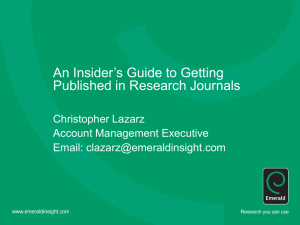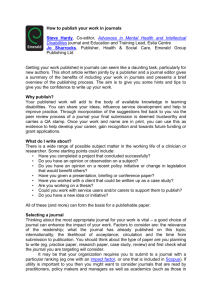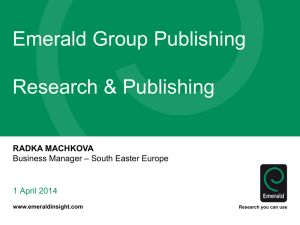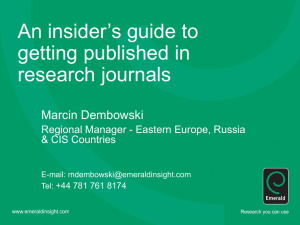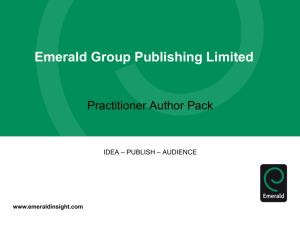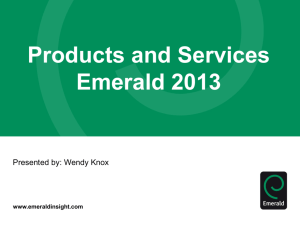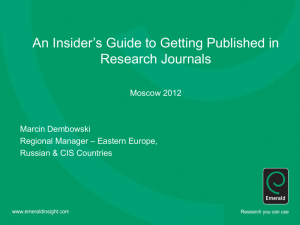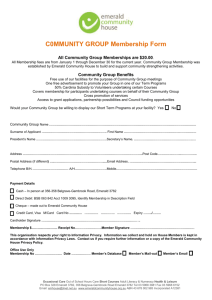Emerald Management Xtra
advertisement
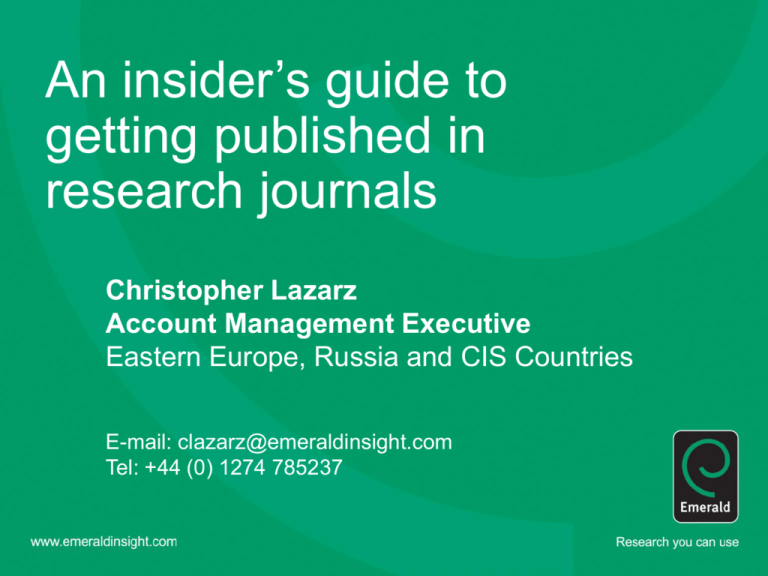
An insider’s guide to getting published in research journals Christopher Lazarz Account Management Executive Eastern Europe, Russia and CIS Countries E-mail: clazarz@emeraldinsight.com Tel: +44 (0) 1274 785237 Aims of the session • To ‘demystify’ the publishing process • To provide tips, insider knowledge and key questions to maximize your chances of publication • To encourage some of you to go beyond publishing, e.g. reviewing, book reviewing, editorial roles • Q&A session: ask anything! • Follow-up: I’m always available to help • To get you sharing your knowledge, i.e. to get you writing Emerald Group Publishing – company background • Emerald Group Publishing Limited (formerly MCB University Press) • Founded in 1967 in Bradford, West Yorkshire • Over 200 employees. Offices in China, India, Malaysia, Australia, Japan, USA • 1996 launched the Emerald Fulltext database • 2005 launch of Emerald Management Xtra – developed with and for business schools • 2008 Series and Books acquisition from Elsevier Emerald’s publishing philosophy • We believe that good management can – must – make a better world • We believe in inclusivity, internationality, innovation and independence • A better-managed world means better government, better business, more equality, meritocracy of race, age and gender, more employment, more wealth • Supportive of scholarly research • Committed to improving author, reader and customer experience. • ‘Research you can use’ Ensuring usefulness • Highlighting implications for practice and research in article abstract • Review procedures include assessment of article applicability • Emerald works with HE institutions and public/academic/professional associations to further this aim • Emerald ensures quick/easy navigation to content for students, teachers, researchers and practitioners Online usage and dissemination of authors’ work: journals • 60,000+ articles online, over 14 years of content in Emerald Management Xtra • 9,000 abstracts from 1989-1994 • Over 18 million downloads in 2007 • Nearly 2 million articles downloaded each month in 2008 • 63% of customer usage occurs outside the UK • New to Emerald: – EarlyCite – 20 new journals for 2009 – Emerald Backfiles (60,000+ articles from over 120 journals; launched 2008) – Emerald Series and Books (acquired 2008) Key differences between books and journals Journals Books Frequency Regular Irregular Format Predominantly electronic Predominantly print Length 1 article = approx 3-6000ww 1 chapter = approx 5-10,000+ Size Tends to be around 6 articles Usually 10-12+ chapters Review Process Typically double-blind peer-reviewed Route to Market Predominantly subscriptions from academic libraries Mixed Libraries and individuals Editorial supply chain and journal management structure: journals Author Quality research papers Editor EAB and reviewers Solicits new papers Research Handles review process Promotes journal to peers Publisher/ Managing Editor The link between the publishing company and editor Production QA – sub-editing and proof reading Access via library Convert to SGML for online databases Hard copy Helps editors succeed in their role and build a first class journal Print production Overall responsibility Despatch for journal Attends conferences Promotion and marketing Develops new areas of coverage Attends conferences Handles production issues Users Added value from publisher Database Third party Being published means… • Your paper is permanent – published material enters a permanent and accessible knowledge archive – the ‘body of knowledge’ • Your paper is improved – through the interventions of editors, reviewers, sub-editors and proof-readers • Your paper is actively promoted – it becomes available to a far greater audience • Your writing is trustworthy – material which has been published carries a QA stamp. Someone apart from the author thinks it’s good Ideas: where to start • As well as ‘traditional’ research… • Are you working on a Doctoral or Master’s thesis? • Have you completed a project which concluded successfully? • Are you wrestling with a problem with no clear solution? • Do you have an opinion or observation on a subject? • Have you given a presentation or conference paper? • If so, you have the basis for a publishable paper Some essentials of a research paper • Purpose of the paper/Introduction • Research methodology used – the ‘whys and hows’ • Literature review – critical examination of what has gone before • References should be: – complete – consistent with the style used in the journal – included in the list (anything not cited can be listed as further reading) • Argument and findings • Conclusion should – restate the purpose, encapsulate the main findings and include the most interesting bits Co-authorship as a possibility • With supervisor, across departments, someone from a different institution • Demonstrates the authority and rigour of the research • Especially useful for cross-disciplinary research • Ensure paper is checked and edited so that it reads as one voice • Exploit your individual strengths • Agree and clarify order of appearance of authors and the person taking on the role of corresponding author Editors and reviewers look for … • Originality – what’s new about subject, treatment or results? • Relevance to and extension of existing knowledge • Research methodology – are conclusions valid and objective? • Clarity, structure and quality of writing – does it communicate well? • Sound, logical progression of argument • Theoretical and practical implications (the ‘so what?’ factors!) • Recency and relevance of references • Adherence to the editorial scope and objectives of the journal Some key questions • Readability – Does it communicate? Is it clear? Is there a logical progression without unnecessary duplication? • Originality – Why was it written? What’s new? • Credibility – Are the conclusions valid? Is the methodology robust? Can it be replicated? Is it honest – don’t hide any limitations of the research? You’ll be found out. • Applicability – How do findings apply to the world of practice? Does it pinpoint the way forward for future research? • Internationality – Does it take an international, global perspective? Target! “Many papers are rejected simply because they don’t fulfil journal requirements. They don’t even go into the review process.” • Identify a few possible target journals/series but be realistic • Follow the Author Guidelines – scope, type of paper, word length, references style, etc • Find where to send your paper (editor, regional editor, subject area editor). Check a copy of the journal/series or the publisher’s web site • Send an outline or abstract and ask if this looks suitable and interesting (or how it could be made so) • Confirm how an editor would like a submission, e.g. e-mail; hard copy • Read at least one issue of the publication – visit your library for access Example of author guidelines Every journal published will have detailed notes and guidelines Emerald has introduced structured abstracts • A structured abstract – in 250 words or less (no more than 100 in any one section) • Purpose – Reasons/aims of paper • Design – Methodology/’how it was done’/scope of study • Findings – Discussion/results • Research limitations/Implications – Exclusions/next steps • Practical implications – Applications to practice/’So what?’ • Originality/value – Who would benefit from this and what is new about it? www.emeraldinsight.com/structuredabstracts Timetable from submission to initial feedback to authors • The Editor(s) do an initial read to determine if the subject matter and research approach of the manuscript is appropriate for the journal (approximately 1 week) • The Editor(s) identify and contact two reviewers for the manuscript (approximately 1 week) • Reviewers are usually given 6-8 weeks to complete their reviews • The Editor(s) assess the reviewers' comments and recommendations and make a decision on the manuscript (approximately 2 weeks) • Expected time from submission to review feedback: 3 - 3.5 months Your own peer review • Let someone else see it – show a draft to one or more friends or colleagues and ask for their comments, advice and honest criticism • We are always too close to our own work to see its failings • Always proof-check thoroughly – no incorrect spellings, no incomplete references. Spell checkers are not fool-proof Spot the error: Leads Metropolitan University If your paper is rejected … • Ask why, and listen carefully! Most editors will give detailed comments about a rejected paper. Take a deep breath, and listen to what is being said • Try again! Try to improve the paper, and re-submit elsewhere. Do your homework and target your paper as closely as possible • Don’t give up! At least 50% of papers in business and management don’t get published. Everybody has been rejected at least once • Keep trying! Revising • A request for revision is good news! It really is • You are now in the publishing cycle. Nearly every published paper is revised at least once • Don’t panic! • Even if the comments are sharp or discouraging, they aren’t personal Process of acceptance for a journal – just one example How to revise your paper • Acknowledge the editor and set a revision deadline • Clarify understanding if in doubt – ‘This is what I understand the comments to mean…’ • Consult with colleagues or co-authors and tend to the points as requested • Meet the revision deadline • Attach a covering letter which identifies, point by point, how revision requests have been met (or if not, why not) Improve electronic dissemination by… • Using short descriptive title containing main keyword – don’t mislead • Writing a clear and descriptive abstract containing the main keywords and following any instructions as to content and length • Providing relevant and known keywords – not obscure new jargon • Making your references complete and correct – vital for reference linking and citation indices • Ensuring your paper is word-perfect Thomson Scientific (ISI) • Thomson Scientific is a subsidiary of the Thomson Group and is based in Philadelphia, USA • Thomson Scientific’s ‘ISI Web of Science’ database scores 9,000 selected journals with ‘Impact Factors’ based on journal citations • The latest Thomson Scientific statistics were published in June 2009 for the year 2008 • Emerald currently has 41 journals ranked on what is still commonly known as ‘ISI’ Thomson Scientific (ISI) What does ISI do? • What is commonly referred to by academics as ‘ISI’, ‘SSCI’ or ‘Impact Factors’ is actually Thomson Reuters now, and more specifically, it’s ‘Journal Citation Reports’ (JCR) • These reports index and rank the journals it has on its ‘ISI Web of Knowledge’ and is a collection of bibliographic information of over 9,000 evaluated scholarly journals • Currently, Emerald has 41 journals ‘on ISI’, i.e. they can be accessed through the ISI Web of Science and are/will be included in the Journal Citation Reports Thomson Scientific (ISI) What is an Impact Factor? • Journals are ranked in the JCR depending on how many times the articles included in that journal are cited in other ISI-ranked journals. The ranking is published every June and corresponds to the previous year’s data. • ISI uses a calculation of citation data over a three year period to produce an Impact Factor for a given year. • For example, the Impact Factor for the Journal of Documentation (Emerald’s highest ranked journal) is 1.439 and relates to 2006. Journal rankings ISI is the most well known ranking, BUT… • It is heavily biased towards North America • Citations are a good, but not complete, guide to quality • Usage is a better measure of utility • Other factors to consider are recent articles, most communicative, societies and internationality • Be political (e.g. national vs international) and strategic (e.g. five articles in ‘low ranked’ journals vs one in ‘top ranked’ journal) What rankings are used here? The Emerald Literati Network • More than 60,000 authors worldwide are members – a huge ‘expert network’ • Authors’ Charter – uniquely provides authors with a range of benefits and sets out levels of service • Emerald journals are members of and subscribe to the principles of the Committee on Publication Ethics • Complimentary journal issue and five reprints upon publication • Calls for Papers and news of publishing opportunities • Editing service • Outstanding Doctoral Research Awards • Research Fund Awards • Annual Awards for Excellence www.emeraldinsight.com/literati www.emeraldinsight.com/awards Emerald Management Xtra – authors’ resources • Comprehensive help and advice every step of the way • How to… guides • Meet the Editor interviews and editor news • Premium help with placing your paper for publication • Publishing opportunities and Calls for Papers www.emeraldinsight.com/authors Talk to us, use us! • Tell us how we can help you – talk to us, give us ideas • Register with Emerald Research Connections www.emeraldinsight.com/connections • Register with Emerald InTouch http://intouch.emeraldinsight.com • Use the Emerald Literati Network • Use Emerald Management Xtra Write for us! Thank you. Any questions? For any answers you didn’t get today (or were too shy to ask) … please e-mail, write or phone: Christopher Lazarz +44 (0) 1274 785237 clazarz@emeraldinsight.com Emerald Group Publishing Ltd Howard House, Wagon Lane, Bingley, West Yorkshire, BD16 1WA England
